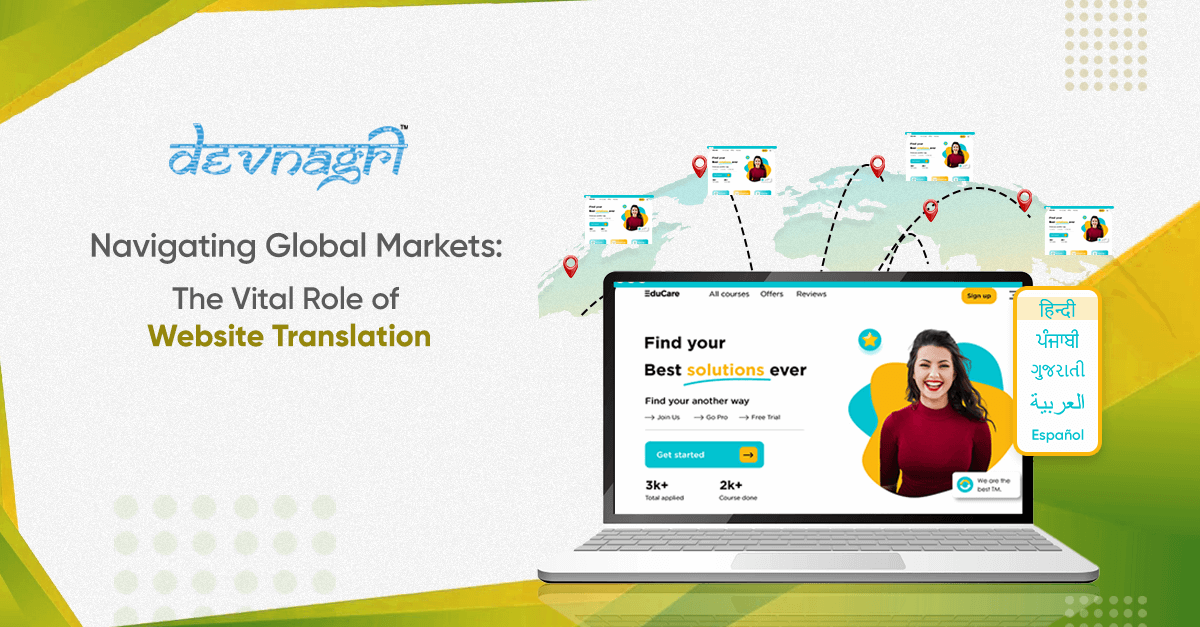
In today’s interconnected world, businesses are constantly seeking ways to expand their reach beyond domestic borders. With the internet erasing geographical boundaries, companies have unprecedented opportunities to tap into international markets. However, to successfully penetrate foreign markets and resonate with diverse audiences, one crucial aspect cannot be overlooked: website translation.
Website translation is not merely about converting text from one language to another; it’s about effectively communicating your brand’s message, values, and offerings in a manner that resonates with the target audience. In this blog, we’ll explore the significance of website translation, its benefits, best practices, and how it can empower businesses to thrive in global markets.
Also Read: Exploring the Power of Translation APIs: Breaking Language Barriers in a Connected World
Understanding the Importance of Website Translation
In the digital age, a company’s website serves as its virtual storefront, often serving as the first point of contact for potential customers. When visitors land on a website, they should feel welcomed, understood, and catered to. However, language barriers can present a significant hurdle in achieving this goal. Research indicates that the majority of consumers are more likely to make a purchase if information is presented in their native language. Therefore, website translation plays a pivotal role in enhancing user experience, fostering trust, and driving conversions.
Also Read: Unlocking Boundless Communication: The Significance of English to Telugu Translation
Unlocking Global Opportunities
Expanding into international markets offers tremendous growth opportunities for businesses. However, to capitalize on these opportunities, companies must speak the language of their target audience—both literally and figuratively. By translating their website into multiple languages, businesses can effectively engage with diverse demographics, strengthen brand perception, and gain a competitive edge in global markets.
Also Read: Enhancing Global Reach: The Importance of Subtitle Translation
Benefits of Website Translation
- Enhanced User Experience: By offering content in multiple languages, businesses cater to the linguistic preferences of their audience, thereby enhancing user experience and reducing bounce rates.
- Improved SEO Performance: Website translation can boost search engine visibility in foreign markets, as localized content is more likely to rank higher in relevant search queries.
- Increased Conversions: Studies have shown that localized content leads to higher conversion rates, as consumers are more inclined to engage with brands that speak their language and understand their cultural nuances.
- Cultural Relevance: Effective website translation goes beyond language; it involves cultural adaptation to ensure that the content resonates with the target audience and aligns with local customs, values, and preferences.
Also Read: Unlocking Communication: The Power of English to Gujarati Translation
Best Practices for Website Translation
- Invest in Professional Translation Solutions: While machine translation tools offer convenience, they often lack accuracy and fail to capture the nuances of language and culture. Investing in professional translation solutions ensures high-quality, culturally sensitive translations that resonate with your audience.
- Localize Content: Localization involves adapting content to suit the linguistic, cultural, and regulatory requirements of specific regions. This includes translating not only text but also images, graphics, currencies, and units of measurement.
- Maintain Consistency: Consistency is key to building brand trust and credibility. Ensure that terminology, tone, and messaging remain consistent across all translated versions of your website.
- Regular Updates: Keep your translated content up to date to reflect changes in your offerings, promotions, or company information. Stale or outdated content can undermine the credibility of your website.
- User Testing: Conduct user testing to gather feedback from target audiences in different regions. This helps identify any linguistic or cultural issues and allows for refinement of the translated content.
Also Read: Navigating the Complexity of Legal Translation: Ensuring Accuracy and Clarity
Conclusion
In today’s globalized marketplace, website translation is no longer a luxury but a necessity for businesses looking to expand their reach and connect with diverse audiences. By investing in professional translation solutions, adhering to best practices, and prioritizing cultural relevance, businesses can unlock a world of opportunities and establish themselves as trusted brands in international markets. Remember, in the digital age, speaking your customers’ language is the key to success.





